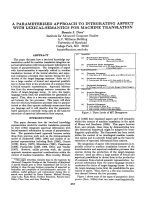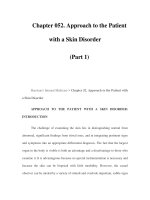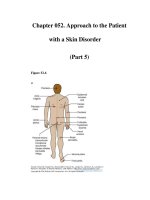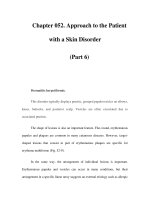Chapter 052. Approach to the Patient with a Skin Disorder (Part 4) doc
Bạn đang xem bản rút gọn của tài liệu. Xem và tải ngay bản đầy đủ của tài liệu tại đây (50.15 KB, 5 trang )
Chapter 052. Approach to the Patient
with a Skin Disorder
(Part 4)
Figure 52-5
Meningococcemia. An example of fulminant meningococcemia with
extensive angular purpuric patches. (Courtesy of Stephen E. Gellis, MD; with
permission.)
Figure 52-4
Necrotizing vasculitis. Palpable purpuric papules on the lower legs are
seen in this patient with cutaneous small vessel vasculitis. (Courtesy of Robert
Swerlick, MD; with permission.)[newpage]
APPROACH TO THE PATIENT: SKIN DISORDER
In examining the skin it is usually advisable to assess the patient before
taking an extensive history. This way, the entire cutaneous surface is sure to be
evaluated, and objective findings can be integrated with relevant historic data.
Four basic features of a skin lesion must be noted and considered during a
physical examination: the distribution of the eruption, the types of primary and
secondary lesions, the shape of individual lesions, and the arrangement of the
lesions.
An ideal skin examination includes evaluation of the skin, hair, and nails as
well as the mucous membranes of the mouth, eyes, nose, nasopharynx, and
anogenital region. In the initial examination it is important that the patient be
disrobed as completely as possible.
This will minimize chances of missing important individual skin lesions
and make it possible to assess the distribution of the eruption accurately. The
patient should first be viewed from a distance of about 1.5–2 m (4–6 ft) so that the
general character of the skin and the distribution of lesions can be evaluated.
Indeed, distribution of lesions often correlates highly with diagnosis (Fig. 52-6).
For example, a hospitalized patient with a generalized erythematous exanthem is
more likely to have a drug eruption than is a patient with a similar rash limited to
the sun-exposed portions of the face. Once the distribution of the lesions has been
established, the nature of the primary lesion must be determined. Thus, when
lesions are distributed on elbows, knees, and scalp, the most likely possibility
based solely on distribution is psoriasis or dermatitis herpetiformis (Figs. 52-7 and
52-8, respectively). The primary lesion in psoriasis is a scaly papule that soon
forms erythematous plaques covered with a white scale, whereas that of dermatitis
herpetiformis is an urticarial papule that quickly becomes a small vesicle. In this
manner, identification of the primary lesion directs the examiner toward the proper
diagnosis. Secondary changes in skin can also be quite helpful.
For example, scale represents excessive epidermis, while crust is the result
of a discontinuous epithelial cell layer. Palpation of skin lesions can also yield
insight into the character of an eruption.
Thus, red papules on the lower extremities that blanch with pressure can be
a manifestation of many different diseases, but hemorrhagic red papules that do
not blanch with pressure indicate palpable purpura characteristic of necrotizing
vasculitis (Fig. 52-4).









